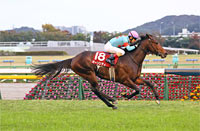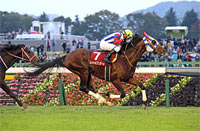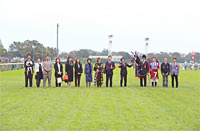Copa Republica Argentina (G2) - Comments from runners' connections

Air Windsor
Takashi Kotaki, assistant trainer
“After his last race, the Tanabata Sho in July, we sent him to the farm and had him gelded there. In the spring things were stagnant and he was just getting bigger and bigger with no desire to run. But now after being gelded he has, in a good way, lost a lot of his stallion-like ways and his body line is much sleeker. There was a much better air about him when he returned to the training center. His condition is good and so are his movement and muscle tone. His footwork was good in his fast work this week and he looked on his game and forward. But, where he used to be too unruly and full of himself, he is now calmer and I think he’ll be able to concentrate on his racing more.” |
|

Authority
Tetsuya Kimura, trainer
“In the Aoba Sho, the jockey gave him a really good ride and he won sharply. His condition had been improving and the race unfolded to his liking. After recovering from a chip fracture and the long time off, he’d gotten pretty pudgy and it will take time to get him fully back. He’s also gotten a bit more headstrong than he was before. Last week, Christophe Lemaire rode him for fast work and he raised his head and was a bit difficult to control. I think his balance isn’t as good as it had been before. This time, it’s a graded stakes race with older horses in the mix but more important than how he’ll measure up is how well he can handle himself. He does still look like he’s returning from a layoff but the main thing is he races without mishap. If he stops being difficult things will go much better. He has matured a lot over the summer and can do well if he can draw on his ability to its fullest.” |
|

Best Approach
Satoru Hatakeyama, assistant trainer
“Two races ago, he returned for the Tomoe Sho after a long layoff and he did better than I thought he would, so after that I was expecting to see even better. But the competition was tougher in his next start, the Grade 3 Hakodate Kinen. Racing from the rear might have been tough for him. Even before he changed stables he was running over longer distances and last time out the jockey said he thought the horse would do better over a wide-open track and more distance. He has had a lot of training and is in a good frame of mind. He’s also better at settling under way now. He did train on the woodchip flat last week but up until then he was training mostly on the hill course. And even though he hadn’t raced in a while he has handled all his training well.” |
|
| Gold Gear (horse, 5)
Keizo Ito, trainer
“He was in good shape for the Niigata Kinen, even though he was returning from time off. And despite the sudden drop in distance there was some nice footwork in the final stage. It was the last week of the meet and the track was pretty bad in places so the plan was to come up the far outside in the finish but the horses in front did the same, so it didn’t help. I gave him a bit of time off after that race but he didn’t lose condition. He worked with the 2-year-old Blue Symphony on Oct. 29 and though there was the difference in rider weights, this one’s movement wasn’t bad. In the spring, he finished fifth in the Grade 2 Meguro Kinen, which is also run over 2,500 meters at Tokyo. And there wasn’t much difference between him and those ahead of him over the finish line and he had made his move from further back than the winner had. The Tokyo long stretch suits him. With a smooth trip I think he can make the top spots.” |
|

Ice Bubble
Yasutoshi Ikee, trainer
“He finished second in the Meguro Kinen this spring and I think if the conditions are a bit different, he’ll be able to do better. He worked under the assistant trainer with Satono Lux this week on the flat and he looked good, for him. He’s the type that does well with a sharpener. And, because he needs time to get up to full speed at the long stretch, Tokyo is good for him. |
|

Last Draft
Yoshinori Saito, assistant trainer
“Last week, he was a bit heavy so the jockey rode fast work and pushed him hard. And this week the trainer rode and just breezed him. He’s full of energy and in good condition. His last start, a handicap at Chukyo, wasn’t a bad race considering he was carrying the top weight and they found afterward that he had a fever. I think you can throw out those results, as they weren’t characteristic. He recovered well and we kept him at the training center in preparation for here. He improved with that prep and is light and fast on his feet now and his times are good. There’s no worry that he won’t settle well, so there shouldn’t be any problem with this distance. He’ll be carrying 56 kg, which is 1 kg lighter than he had last out. I think if he can get some cover, he’ll be able to run well in the final stage. He has talent but hasn’t been able to demonstrate that in his recent races. I’m hoping he will here.” |
|

Meisho Tengen
Kaneo Ikezoe, trainer
“In the Takarazuka Kinen, I think the difficult ground was actually good for him. He gave us a pretty good race up against some tough competition. With this race as our target, I brought him back to the training center early and have given him a lot of work. Over the summer he has gotten a lot stronger. Last week, the jockey rode him as he trained with another horse and he got a pretty hard workout. His action was good and all has gone well. This week his time was slow but the assistant riding him was heavy, so that likely made the difference. Even though he’s coming back from a layoff, I think he’ll go to the gate in good shape. The more distance he has the better for him, so 2,500 meters is within his capability. He’s been able to settle and race very balanced recently. It would be good for him if the track were a bit slower than it normally is at this time of year. He’s matured with the time off and I’m hoping he’ll give us a good race.” |
|
| Musee Alien (gelding, 8)
Yoichi Kuroiwa, trainer
“He breezed over the flat this week working with another horse and looks in good physical condition. His 14th-place finish in the Meguro Kinen was due to interference and he wasn’t able to get a clear run. He is suited to this course.” |
|

Ocea Great
Masatoshi Kikukawa, trainer
“I’d raced him from the beginning of the year so, he was no doubt tired out and in need of some time off. I calculated backward from this race and brought him back to the training center on Oct. 2. He has trained on the woodchip course for three weeks working together with another horse and he improved with each workout. This week it’s just putting on the final touch. He’s fully ready now so should be able to get better results than what he has the last two outings. The conditions and the 2,500 meters over turf are perfect for him. And with it being a handicap I believe it’ll be even better. His recent results haven’t been the best so I’m hoping he’ll give it his all.” |
|

Prince of Pesca
Yasunori Miura, assistant trainer
“He has never had the best racing sense and with the first turn coming right after the break in his last start, the Tancho Stakes in Sapporo, it didn’t suit him all that well. He wasn’t well-balanced. After that race we let him have some rest then got him ready with this race as our target. He did look heavy when he came back to the training center, but now he looks like he’s gotten better with each workout. Last week he looked like himself again and I think he’ll be ready if the preparation goes like this until raceday. The change to Tokyo is a plus. He’s good over a long stretch. He doesn’t have a sharp turn of foot, but he has staying power and if the race calls for that, it’ll be good for him.” |
|

R Star
Haruki Sugiyama, trainer
“Two races ago, he was carrying only 53 kg and had a very good trip. But, last out in the Niigata Kinen, he didn’t take well to the shape of the course and the way the race unfolded. The conditions didn’t suit him. Still, he covered the last three furlongs in only 33-some seconds. He had a good solid bit of fast work last week and he’s in good condition. Yoshihito Nagaoka rode him and the horse is listening to the jockey’s signals now. He’s clear on his gate issues too. We simply won’t know how he’ll take to the Tokyo 2,500 meters unless we give it a try and this is exactly why he was entered, to see how he’ll do at this distance. I’m looking forward to seeing what he’ll give us.” |
|

Sanrei Pocket
Yoshitada Takahashi, trainer
“In the Mainichi Okan last out the jockey rode a good 1,800-meter race, by sending him more forward from the gate and getting a good position. Even though he was traveling much further forward than usual, he ran solidly to the end. His post position was a bit toward the outside and I think the distance he finished off the winner was equal to the distance in extra ground he covered. He handled the distance well too. It was a good race. His condition didn’t suffer at all afterward and he has gotten lots of work since. Last week, just looking at him you could see that he had improved. Even though he was able to handle 1,800 meters, I think this time’s 2,500 meters is actually better for him distance-wise. He put up a good fight amid strong competition last out and I’m hoping now for an even better race given the change in distance and the change to a lefthanded track.” |
|

Satono Lux
Yasutoshi Ikee, trainer
“His run in the Kokura Kinen was pretty wishy-washy and it looks like the heat got to him. It can’t be helped. As part of my plans to get him freshened up again, I sent him to the farm after that and, with this race as our target, brought him back to the training center on Oct. 13. When he came back, even though I would have liked to have him looking a bit leaner, a bit sharper, his work was fine. He got a good blowout on Oct. 29 over the woodchip flat and I think that sharpened him up quite a bit. This week he worked with Ice Bubble on the flat with a focus on the finish. It wasn’t bad but with the trauma of the fracture he suffered in the Kikuka Sho (Japanese St. Leger) if he’s lacking anywhere it seems to be more mental than physical. A wide-open course with a long stretch is, without a doubt, much easier for him than a tight-turned 2,000-meter race like his last one.” |
|

Sun Appleton
Eiji Nakano, trainer
“Before his last start, the Grade 2Sankei Sho All Comers, he’d had six months off. He was still a bit heavy so with that prep behind him we’ll see how much he has improved. His breathing has gotten better but overall, I don’t have the impression that he’s improved all that much. I want to get him just a bit leaner by raceday. He’s not a temperamental horse and he’ll ride the pace well and I think he’ll rise to the level of the others. He adapts easily to different courses so the change to Tokyo shouldn’t be a problem. He’s not bothered much by how the race unfolds so we’ll see how he does on this second start of the season.” |
|

Taisei Trail
Yusaku Oka, assistant trainer
“In the Kyoto Daishoten, he traveled from a more forward position than he has of late but still didn’t do well. He’s been showing an unpleasant side of him in training and I think that was a part of it. Otherwise, everything went as usual after his last race. He’s already 5 years old so his condition is more or less stable with no sudden changes. Everything is as it usually is. Last year he finished second here and came up the inside. Usually he’s not too bothered by how the race unfolds and will run his own race. He used to run more aggressively but nowadays, we can’t be sure if he’ll run seriously until the actual race.” |
|

Tosen Cambina
Yukihiro Kato, trainer
“Since the gate has been a problem, he got a lot of gate practice, but I think he was too tensed up last start. Nonetheless, I think he broke well. But, since he had drawn wide, he had to chase the others, which was something new for him and it looked like he didn’t handle it that well. This last start was his first race in a while and the first since changing stables. He showed a slight fever afterward but this race was our target and we were able to get him ready for it. I think, physically, he’ll show improvement. His last start was over 2,000 meters and I think that he’s better suited to more distance. So, the 2,500 meters this time should be good for him. He’s not very good over a soft or shifting track so ideally we’ll get a fast track. I’m hoping he’ll break well and move gradually up to within striking distance.” |
|

Valerio
Ikuo Aizawa, trainer
“He didn’t like the going in the Tanabata Sho and never really fired his engine, so he was able to really rally in the Tancho Stakes last out. If he has a fast track and a smooth trip he can show you some good racing. He was runnerup but it was a solid loss and I think you can write it off largely to his having moved early up the outside. He got ready at the farm and came back to the training center on Oct. 3. And this time he looked good too. He worked with another horse two weeks ago and moved very nicely, and last week he moved up the outside and caught and finished ahead of the other. It was a hard workout and his footwork was good. He’s lost any stiffness and I can’t see anywhere he comes up short. If he can hold back and keep something in reserve, he has a good turn of foot. To me he looks ready both mentally and physically and he’s of high enough caliber that he really should be able to win another graded-stakes race. It’s a handicap this time too and, depending on the trip he gets, I think he’ll be able to put up a good fight.” |
|

You Can Smile
Yasuo Tomomichi, trainer
“He stayed at the farm in Hokkaido since the Tenno Sho (Spring) and came back to the training center early, so he’s had about two months of work and will be able to race well even though he’s coming back from a layoff. He did look heavy on his feet at first, but with regular training, now he looks much improved. A week before the race, on Oct. 29, I had jockey Yasunari Iwata ride him and chase down another horse on the woodchip course. He pushed him hard and things looked good. Because he had that last week, this week I just did a bit of fine-tuning to keep his breathing good. He’ll surely be able to put up a good fight. He’s gotten stronger on his right side and can race well to the right now and stay straight without lugging in. But, still, his best venue is Tokyo with its long stretch. His work usually carries over well to his races and I don’t think the long time off will mean he’s any less than he could be. Even with the differences in assigned weight, I think he’ll be able to do well.” |
|
Sources: Keiba Book, Netkeiba, Gallop
|

- Preview
- Barrier draw
- Past performances of runners

- News
- Race result
- Video
- 2020 English

- 2019 English

- 2018 English

- 2017 English

- 2016 English

- 2015 English

- 2014 English

- 2013 English

- Photo Gallery
2020 Winner: Authority

2019 Winner: Muito Obrigado


|





